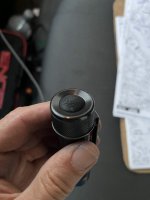A bit more than a year ago, I was curious about the parasitic drain of my rotaries and the effect of using the locator beacon. I devised a crude experiment around being able to measure voltages to 0.01V precision: I have tested (to my best effort) the capacities of three of my 16340 cells, and after a full charge put them 1) in Brass rotary (NB40) with locator beacon ON; 2) in Titanium rotary (NB45) with locator beacon OFF; 3) to rest on my desk. I measured the voltage of each the cells at approximately regular intervals for ~1 month (see caveats below) and obtained the following graph:
View attachment 34159
Markers are raw voltage measurements (with error bars indicating my measurement precision). I then digitized the cell's nominal discharge curve at low current draw from
lygte-info.dk and constructed discharge functions normalized to measured capacities of each cell. Non-linear least-squares fit provided an estimate of the actual drain of each cell.
I think it is fairly clear that the locator beacon has a significant impact on standby current. Very approximately, the locator beacon would fully discharge a 850mAh cell in about 160 days, or about nine months for a CR123A with 1400mAh (ignoring for now the different voltages between 16340 and CR123A, since this is all very rough to begin with). This more or less matches my experience, where an otherwise unused rotary with beacon on would indicate low battery after a few months. With the locator beacon off, standby only adds a very small parasitic drain to the self-discharge. It would take on the order of years to fully drain a rechargeable cell, at which point the self-discharge would have already done so. For a CR123A, this would take significantly longer since primaries have less self-discharge.
My take away is that if you are actively using the light and cycling through cells with any regularity, then the locator beacon adds insignificant amounts of battery consumption. On the other hand, it doesn't seem advisable to activate the beacon with a battery inside if it's in storage for more than a few months.
Now for the caveats: 1) I would have like to have measured for many more days, but life got in the way; 2) I did have to remove the cells to measure the voltages, which means these measurements are not
in situ. However, this shouldn't be a big effect, since the current draw is so small; 3) Removing the cells in between also meant that sometimes I wasn't quick enough to replace the cells before the lights reset, so the reset flashes and/or the extra on/off cycles to turn off the locator beacons would contribute to the drain. I roughly approximated the effect and it comes out to a few percent difference averaged over the course of every measurement cycle, so I think it is acceptable. Nonetheless, all of this should be taken to be upper bounds of parasitic drain, since more careful and less perturbative measurements are certainly possible.


